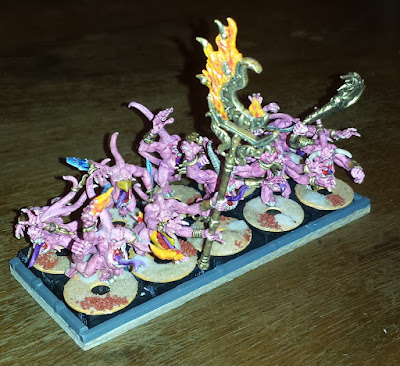Previous attempts
I tried to carve a movement tray out of a wooden plank. Of course, they don't sell planks of the required size, so I bought a hand saw and cut it down to size - only to have a rough, jagged edge, no matter how I tried to do it right. Demoralized, I shelved the project.
The proper material: balsa wood
To quote Wikipedia: Balsa lumber is very soft and light, with a coarse, open grain.
For our purposes, this means that a 4 mm thick balsa plank can be cut to size using a cutter. Use a pen or pencil to draw out the required lines, then use a ruler and follow it with the cutter. It requires some practice to keep the blade straight.
The final product is an almost-perfectly sized plank.
More stuff needed: universal glue (i.e. something that will glue plastic and metal to wood), PVA glue.
Movement trays for Warhammer Fantasy (type 1)
I already have a set of magnetized bases; it's just clumsy to push a horde of models around with no tray. I don't use the square bases for anything else, so the first option was to glue them directly on the wooden plank.
As always, dry fit the components:
Then go ahead and and glue them on using your universal glue.
Put something heavy on this and leave it like that for the night. I had it pressed for a couple of days. Then use the PVA glue sealant technique on the wood, and you're done.
Of course, this option has the shortcoming of using up your magnetized bases. As old people say, you'll never know when they'll be useful. So I tried something that leaves me with the bases untouched.
Movement trays for Warhammer Fantasy (type 2)
Let's glue a magnetic sheet unto the wooden plank; then the magnets in the bases will hold both to the sheet and to the metallic bases of the models. Of course, the link between the bases and the magnetic sheet is a bit weaker, so I used old bits of sprue as a kind of railing on the edges.
Because of the 'railing', your planks needs to be larger than the actual 'footprint' of the models. Sprue holders are 4 mm wide, so for a 20-man Daemon squad, we need a 133x54 mm plank:
The magnetic sheet needs to be of the exact size, 125x50 mm.
Then prepare and dry fit the sprue guards:
One side guard is a bit longer than the plank. I did not keep my cutter's blade exactly right, so it veered off a bit and this is the result. We'll solve that immediately.
Glue on the magnetic sheet. Make sure to fit it exactly where it needs to go, respecting the boundaries:
Due to the defect explained above, the sheet is also larger than the plank. That's easy to fix. Put the movement tray sheet-down on a hard surface, such as this wooden plank:
Then trace it's contour with a cutter. That should slice off the extra sheet.
On to the sprue guard! Make sure to dry fit.
I used a hobby knife to hack of a couple of millimeters off the side guard, so as to make it the right size.
While working with the plastic, the sprue bits might slightly bend, and then they won't stick closely to the wooden surface. Put something heavy on top, like a pile of books, and leave it to press down. Finally, seal the wood using the PVA glue technique.
Comparison
I tested the movement trays at home. They both seemed to work well enough.
I then used them to transport some miniatures to and from a game of Frostgrave (I mounted the miniatures on the trays, then put the trays inside a box). I came to the conclusion that, for my setup, the type (1) tray is far superior.
- It holds the miniatures a lot better. This one is obvious, as the magnets are glued to the plank. I can safely place the tray at any angle, even turn it upside down, and nothing will fall off. If I shake it upside down, heavier metal models do fall off, but everything plastic stays in place. I can move the other one around, but the magnetic sheet isn't strong enough to hold at steep angles or sudden movements.
- It's easier to mount/unmount the miniatures. The base is glued to the tray; the miniature sticks to the base. When using the other one, there's a tray, a base and the miniature; the base sometimes sticks to the miniature and not the tray, and it has to be removed when placing the miniature on the table.
That being said, if I had glued my miniatures to their round bases, and glued a magnet underneath, the type (2) tray would have been better, as I wouldn't have had to also buy square bases.
But for now, I'll stick to type (1) and manufacture a couple more. Soon to be used in Warhammer Fantasy!



















No comments:
Post a Comment